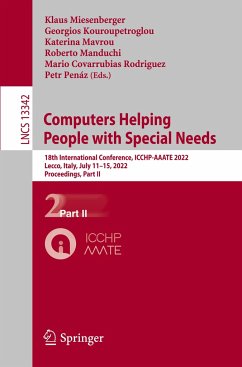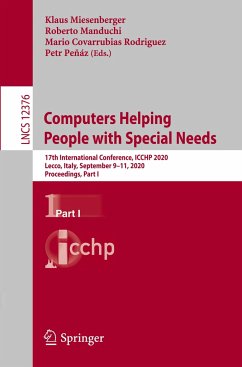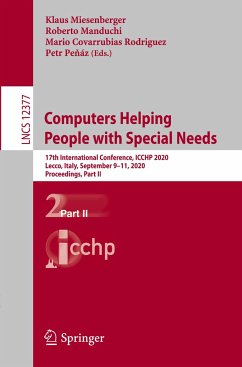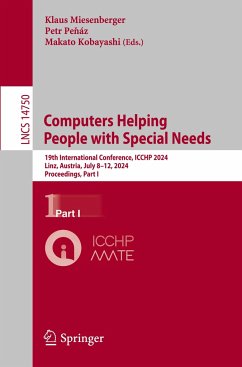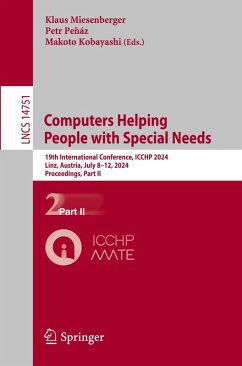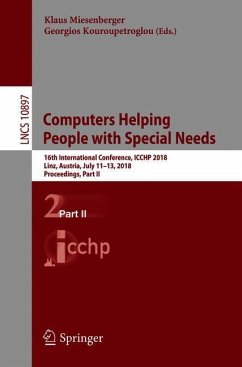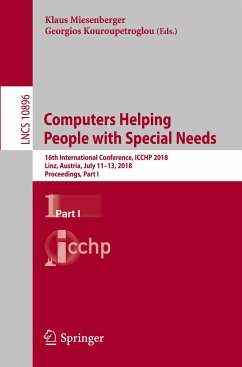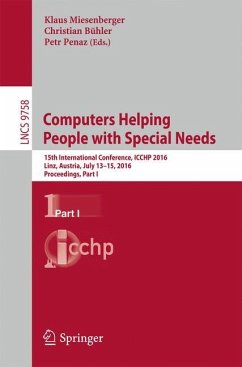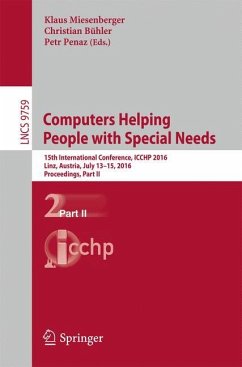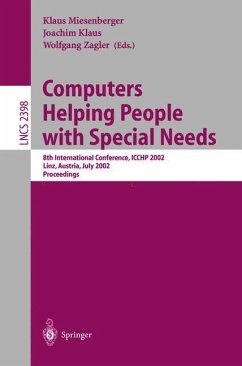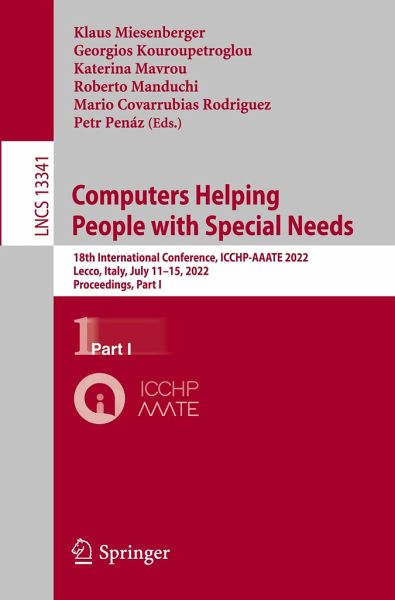
Computers Helping People with Special Needs
18th International Conference, ICCHP-AAATE 2022, Lecco, Italy, July 11-15, 2022, Proceedings, Part I
Herausgegeben: Miesenberger, Klaus; Kouroupetroglou, Georgios; Mavrou, Katerina; Manduchi, Roberto; Covarrubias Rodriguez, Mario; Penáz, Petr

PAYBACK Punkte
27 °P sammeln!
The two-volume set LNCS 13341 and 13342 constitutes the refereed proceedings of the Joint International Conference on Digital Inclusion, Assistive Technology, and Accessibility, ICCHP-AAATE 2022. The conference was held in Lecco, Italy, in July 2022.The 112 papers presented were carefully reviewed and selected from 285 submissions. Included also are 18 introductions. The papers are organized in the following topical sections:Part I: Art Karshmer Lectures in Access to Mathematics, Science and Engineering; Digital Solutions for Inclusive Mobility: solutions and accessible maps for indoor and out...
The two-volume set LNCS 13341 and 13342 constitutes the refereed proceedings of the Joint International Conference on Digital Inclusion, Assistive Technology, and Accessibility, ICCHP-AAATE 2022. The conference was held in Lecco, Italy, in July 2022.
The 112 papers presented were carefully reviewed and selected from 285 submissions. Included also are 18 introductions. The papers are organized in the following topical sections:
Part I: Art Karshmer Lectures in Access to Mathematics, Science and Engineering; Digital Solutions for Inclusive Mobility: solutions and accessible maps for indoor and outdoor mobility; implementation and innovation in the area of independent mobility through digital technologies; haptic and digital access to art and artefacts; accessibility of co-located meetings; interactions for text input and alternative pointing; cognitive disabilities and accessibility; augmentative and alternative communication (AAC): emerging trends, opportunities and innovations; language accessibility for the deaf and hard-of-hearing.
Part II: Digital accessibility: readability and understandability; serious and fun games; internet of things: services and applications for people with disabilities and elderly persons; technologies for inclusion and participation at work and everyday activities; robotic and virtual reality technologies for children with disabilities and older adults; development, evaluation and assessment of assistive technologies; ICT to support inclusive education - universal learning design (ULD); design for assistive technologies and rehabilitation; assistive technologies and inclusion for older people.
The 112 papers presented were carefully reviewed and selected from 285 submissions. Included also are 18 introductions. The papers are organized in the following topical sections:
Part I: Art Karshmer Lectures in Access to Mathematics, Science and Engineering; Digital Solutions for Inclusive Mobility: solutions and accessible maps for indoor and outdoor mobility; implementation and innovation in the area of independent mobility through digital technologies; haptic and digital access to art and artefacts; accessibility of co-located meetings; interactions for text input and alternative pointing; cognitive disabilities and accessibility; augmentative and alternative communication (AAC): emerging trends, opportunities and innovations; language accessibility for the deaf and hard-of-hearing.
Part II: Digital accessibility: readability and understandability; serious and fun games; internet of things: services and applications for people with disabilities and elderly persons; technologies for inclusion and participation at work and everyday activities; robotic and virtual reality technologies for children with disabilities and older adults; development, evaluation and assessment of assistive technologies; ICT to support inclusive education - universal learning design (ULD); design for assistive technologies and rehabilitation; assistive technologies and inclusion for older people.



